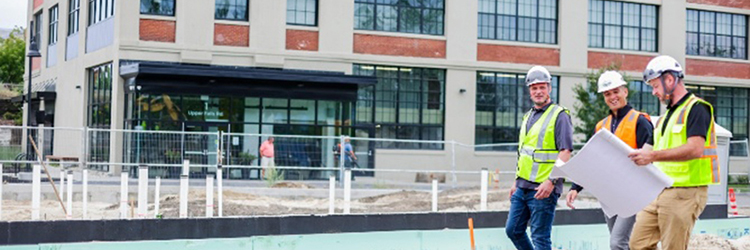Industrial markets: Northern New England markets have benefited from spillover effect - by Bill Pastuszek

New England opened up in the spring, and, now in early September, everything is open but we are worried again. We were told it wouldn’t be over as soon as we thought it would be and that seems to be holding true. A couple steps forward, some backward. Progress, but feels like regressing rather than progressing.
Residential real estate continues to shine brightly into all areas of New England. Favorable market conditions are driven by COVID-19 demand and a lack of inventory due to many factors but certainly in terms of the lack of new construction.
In commercial markets, after a 2020 pause, market participants cautiously re-engaged and market activity has been regarded as increasingly positive in those sectors that were forecast to emerge strongly from the pandemic’s effects, namely multi-family and industrial sectors.
Let’s consider industrial. In a 2020 pre-COVID CBRE study, it was forecast that “supply would outpace demand, creating a slight overhang of space. Vacancy [was] likely to increase, but only slightly.”
CBRE’s Market 2021 overview noted that “the Greater Boston Industrial market is quickly becoming one of the strongest in the nation and continued to build momentum at a record-setting pace in the second quarter of 2021. Almost 1.5 million s/f of positive absorption was recorded in the second quarter and 2.7 million s/f year-to-date, highlighting the explosive growth in the region. Asking rents continued to rise quickly, finishing the quarter at $10.53 per s/f NNN.”
The CBRE report goes on to say, “Boston has earned a seat at the table with the country’s most historically dominant industrial markets after clocking an unprecedented year-over-year rent growth of 14.8%, the sixth-largest.”
Boston’s surging local economy has created strong demand for final-mile logistics space. As industrial sites have been taken out of service due to demand for housing sites, there has been growing demand for logistics space. This is true not only in the core Boston area but in outlying areas, including Northern New England.
Northern New England markets have benefited from a spillover effect as well as from direct demand. As COVID has sharpened appetites for remote work, it is certainly reasonable to expect that companies that can afford to move into lower density areas will do so to attract and retain workers and enjoy lower living, housing, and business costs.
Maine’s industrial market consists of +/-59,000,000 s/f. Major additions to the inventory are surveyed at about 100,000 s/f per year over the past five years. Southern Maine benefits from proximity to Boston while further north the market is thinner with lower occupancies and rents.
The Maine market is currently experience high occupancy, i.e., in excess of 95%. Asking rents have doubled in 3+ years to +/-$8 per s/f NNN. Cap rates tend to be higher than in the Boston market but have shown compression over the recent past. Sale prices - measured on a price per square foot of building basis – have also trended up. Sales activity is much lower than closer to Boston and at least two reasons for that are: a smaller overall market and less overall demand.
The Dunham Group reports the following with respect to the Portland market. The total market size is 20+ million s/f with a vacancy rate of less than 2.5%, average sales price per s/f have shown a very steady positive increase over the past decade, almost doubling during that period. Lease rates have shown a flatter rate of increase. The study notes the ability of the industrial market to “adapt and prosper” during COVID and it is likely to continue to do so.
Boston’s industrial market continues to benefit from the growth of the life sciences industry. That sector has shown a trend towards migrating to the suburbs to benefit from lower costs. Expect some interesting trends to continue to emerge. Another area to watch is cannabis.
In early 2021, overall industrial vacancy is down from 5% in mid-2020 with average asking rents continuing to trend upward from 2020s average $11.75 per s/f. Per square foot prices have continued to increase, with cap rate trending downward. Net absorption is positive.
Industrial has been the top performing asset class for several years running—and COVID-19 hasn’t done much to change that perception. Prospects for the Boston industrial sector in general show a largely positive trend and, while some concerns are raised about a bubble, much of the activity has to fulfill real, long-term needs.
Northern New England markets have participated in this run up. While the markets are much smaller, they show great strength from local factors as well as benefitting from what is happening in Boston.
Potential near and mid-term negative trends include U.S. and global uncertainties, COVID-19 resurgences, inflation, and concern about real estate bubbles. Markets need to be observed with care, without falling prey to overreacting to short-term trends and rumors and to understand that most investor behavior is over a long horizon.
William Pastuszek, Jr., MAI, ASA, MRA heads up Shepherd Associates LLC, Needham, Mass.
Reveler Development celebrates final phase of work at The Levee - new 51-unit apartment building in Biddeford


Interest rates and inflation - by Matthew Bacon
As we all know, interest rates have been changing drastically, with movement in both directions, depending on the type and term of financing. The Federal Open Market Committee has taken drastic action in efforts to curb abnormally high inflation, but it hasn’t controlled labor cost growth to the extent that was intended.

The Greater Portland industrial mid-year market update - by Nate Roop

Maine multifamily outlook: Opportunities in Portland, Bangor, and Lewiston-Auburn - Blake Wright and Kristie Russell
The multifamily market in Maine’s major cities presents a diverse range of opportunities for investors. We looked at the potential benefits and unique characteristics of three major submarkets in the state: Portland, Bangor, and Lewiston-Auburn. The information below is based on research done in CoStar and county registries, and focuses on multifamily properties that have four or more units.


 (1) (1).png)





.png)


.png)